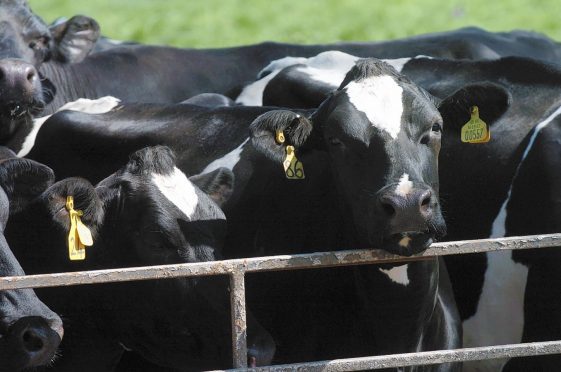Dairy cows have been bred so big they’re now struggling to fit into their cubicles and milking parlours.
For years dairy cows have been growing in stature and there is now a concern that huge Holsteins are outgrowing their allotted spaces and risk incurring extra costs for farmers.
Milk producers were told at an industry meeting in Aberdeen that the trend needs to be arrested to ensure efficiency.
Andy Dodd, a technical manager with the farm levy board AHDB, said a ‘maintenance value’ had been added into the most commonly used breeding indices to try to stop UK dairy cattle getting any bigger.
It means farmers can select bulls for size and should see fewer very large cows being bred.
Mr Dodd said: “We don’t necessarily need cow size to reduce, we just need them to stop getting bigger and bigger.
“The maintenance value will estimate how far above or below the average weight the daughter of the sire is likely to be, and to keep size at a reasonable levels. We want farmers to select those which are likely to be lighter than average.
“Maintenance is really about efficiency. Historically farmers bred bigger animals to produce more milk, but we know smaller animals can produce just as much, so often bigger cows simply cost more to feed.
“There is also a concern on many farms about cows outgrowing the cubicles in both sheds and parlours and incurring extra costs there.”
He also emphasised understanding the herd and production requirements was key to getting selection right.
He said: “For dairy farmers working on contract they will generally need to select for volume, fat and protein, however the criteria processors are looking for can often vary hugely so producers really need to tailor their cattle breeding plans to their system.
“Other producers may be looking to improve the health of their herd and so should be prioritising things like fertility, lifespan and somatic cell counts.”
To help with selection decisions AHDB Dairy’s website allows farmers to create a Herd Genetic Report for their farm. The tool identifies the genetic strengths and weaknesses in an individual herd, to help producers tailor their breeding choices.
They can then use the AHDB Dairy Breeding webpage to compare bulls and traits from across the UK. Farmers pick their preferred breed and then search for the key criteria they are looking for, whether it is high milk production, specific fat and protein levels, or a combination these and other traits. They will then be presented with all bulls in the UK which meet those criteria.
